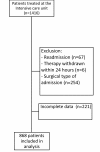Carboxyhemoglobin levels in medical intensive care patients: a retrospective, observational study
- PMID: 22236404
- PMCID: PMC3396235
- DOI: 10.1186/cc11138
Carboxyhemoglobin levels in medical intensive care patients: a retrospective, observational study
Abstract
Introduction: Critical illness leads to increased endogenous production of carbon monoxide (CO) due to the induction of the stress-response enzyme, heme oxygenase-1 (HO-1). There is evidence for the cytoprotective and anti-inflammatory effects of CO based on animal studies. In critically ill patients after cardiothoracic surgery, low minimum and high maximum carboxyhemoglobin (COHb) levels were shown to be associated with increased mortality, which suggests that there is an 'optimal range' for HO-1 activity. Our study aimed to test whether this relationship between COHb and outcome exists in non-surgical ICU patients.
Methods: We conducted a retrospective, observational study in a medical ICU at a university hospital in Vienna, Austria involving 868 critically ill patients. No interventions were undertaken. Arterial COHb was measured on admission and during the course of treatment in the ICU. The association between arterial COHb levels and ICU mortality was evaluated using bivariate tests and a logistic regression model.
Results: Minimum COHb levels were slightly lower in non-survivors compared to survivors (0.9%, 0.7% to 1.2% versus 1.2%, 0.9% to 1.5%; P=0.0001), and the average COHb levels were marginally lower in non-survivors compared to survivors (1.5%, 1.2% to 1.8% versus 1.6%, 1.4% to 1.9%, P=0.003). The multivariate logistic regression analysis revealed that the association between a low minimum COHb level and increased mortality was independent of the severity of illness and the type of organ failure.
Conclusions: Critically ill patients surviving the admission to a medical ICU had slightly higher minimum and marginally higher average COHb levels when compared to non-survivors. Even though the observed differences are statistically significant, the minute margins would not qualify COHb as a predictive marker for ICU mortality.
Figures




Comment in
-
Carboxyhemoglobin levels in medical intensive care patients.Crit Care. 2012 Feb 16;16(1):411; author reply 411. doi: 10.1186/cc11163. Crit Care. 2012. PMID: 22340108 Free PMC article. No abstract available.
Similar articles
-
Arterial carboxyhemoglobin level and outcome in critically ill patients.Crit Care Med. 2007 Aug;35(8):1882-7. doi: 10.1097/01.CCM.0000275268.94404.43. Crit Care Med. 2007. PMID: 17568332
-
Arterial carboxyhaemoglobin levels in children admitted to PICU: A retrospective observational study.PLoS One. 2019 Mar 7;14(3):e0209452. doi: 10.1371/journal.pone.0209452. eCollection 2019. PLoS One. 2019. PMID: 30845230 Free PMC article.
-
Carboxyhemoglobin and lactate levels do not correlate in critically ill patients.Am J Ther. 1999 Sep;6(5):241-4. doi: 10.1097/00045391-199909000-00003. Am J Ther. 1999. PMID: 11329105
-
Carboxyhemoglobin half-life in carbon monoxide-poisoned patients treated with 100% oxygen at atmospheric pressure.Chest. 2000 Mar;117(3):801-8. doi: 10.1378/chest.117.3.801. Chest. 2000. PMID: 10713010 Review.
-
Use of carboxyhemoglobin as a biomarker of environmental CO exposure: critical evaluation of the literature.Environ Sci Pollut Res Int. 2017 Nov;24(33):25798-25809. doi: 10.1007/s11356-017-0270-1. Epub 2017 Oct 13. Environ Sci Pollut Res Int. 2017. PMID: 29027621 Review.
Cited by
-
Carboxyhemoglobin as biomarker of late-onset sepsis in preterm infants.Eur J Pediatr. 2023 Oct;182(10):4523-4528. doi: 10.1007/s00431-023-05120-y. Epub 2023 Jul 27. Eur J Pediatr. 2023. PMID: 37498388 Free PMC article.
-
Carboxyhemoglobin Does Not Predict the Need of Mechanical Ventilation and Prognosis during COPD Exacerbation.Can Respir J. 2022 Apr 16;2022:6689805. doi: 10.1155/2022/6689805. eCollection 2022. Can Respir J. 2022. PMID: 35469243 Free PMC article.
-
Carboxyhemoglobin predicts oxygenator performance and imminent oxygenator change in extracorporeal membrane oxygenation.Intensive Care Med Exp. 2024 Apr 24;12(1):41. doi: 10.1186/s40635-024-00626-7. Intensive Care Med Exp. 2024. PMID: 38656714 Free PMC article.
-
Carboxyhemoglobin levels during human inflammation.Crit Care. 2012 Dec 12;16(2):24. doi: 10.1186/cc11295. Crit Care. 2012. PMID: 22524427 Free PMC article. No abstract available.
-
Carboxyhemoglobin levels in medical intensive care patients.Crit Care. 2012 Feb 16;16(1):411; author reply 411. doi: 10.1186/cc11163. Crit Care. 2012. PMID: 22340108 Free PMC article. No abstract available.
References
-
- Berk PD, Blaschke TF, Scharschmidt BF, Waggoner JG, Berlin NI. A new approach to quantitation of the various sources of bilrubin in man. J Lab Clin Med. 1976;87:767–780. - PubMed
MeSH terms
Substances
LinkOut - more resources
Full Text Sources
Other Literature Sources
Medical

